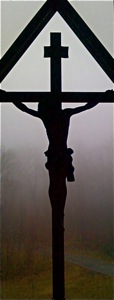Difference between revisions of "Crucifixion"
(Created page with 'File:lighterstill.jpgright|frame '''Crucifixion''' is an ancient method of painful execution in which the condemned person is tied or naile...') |
|||
| Line 6: | Line 6: | ||
A crucifix (an image of Christ crucified on a cross) is the main religious [[symbol]] for Catholics, Eastern Orthodox and Oriental Orthodox, but most Protestant Christians prefer to use a cross without the figure (the "corpus" - Latin for "body") of Christ. The term crucifix derives from the Latin crucifixus or cruci fixus, itself the past participle passive of crucifigere or cruci figere, "crucify", "fix to a cross."[4][http://en.wikipedia.org/wiki/Crucifixion] | A crucifix (an image of Christ crucified on a cross) is the main religious [[symbol]] for Catholics, Eastern Orthodox and Oriental Orthodox, but most Protestant Christians prefer to use a cross without the figure (the "corpus" - Latin for "body") of Christ. The term crucifix derives from the Latin crucifixus or cruci fixus, itself the past participle passive of crucifigere or cruci figere, "crucify", "fix to a cross."[4][http://en.wikipedia.org/wiki/Crucifixion] | ||
| + | |||
| + | <center>For lessons on the [[topic]] of '''''[[Crucifixion]]''''', follow [http://nordan.daynal.org/wiki/index.php?title=Category:Crucifixion this link].</center> | ||
[[Category: General Reference]] | [[Category: General Reference]] | ||
[[Category: Religion]] | [[Category: Religion]] | ||
Revision as of 10:45, 6 September 2009
Crucifixion is an ancient method of painful execution in which the condemned person is tied or nailed to a large wooden cross (of various shapes) and left to hang until dead. The term comes from the Latin crucifixio, fixed to a cross, from prefix cruci-, cross, + verb ficere, fix or do.[1]
Crucifixion was in use particularly among the Persians, Seleucids, Carthaginians, and Romans from about the 6th century BC to the 4th century AD, when in the year 337 Emperor Constantine I abolished it in his empire, out of veneration for Jesus Christ, the most famous victim of crucifixion.[2][3] It has sometimes been used even in modern times.
A crucifix (an image of Christ crucified on a cross) is the main religious symbol for Catholics, Eastern Orthodox and Oriental Orthodox, but most Protestant Christians prefer to use a cross without the figure (the "corpus" - Latin for "body") of Christ. The term crucifix derives from the Latin crucifixus or cruci fixus, itself the past participle passive of crucifigere or cruci figere, "crucify", "fix to a cross."[4][1]
